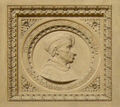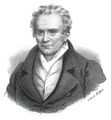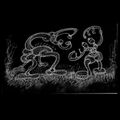Template:Selected anniversaries/May 9: Difference between revisions
No edit summary |
No edit summary |
||
| Line 25: | Line 25: | ||
||1904 – The steam locomotive City of Truro becomes the first steam engine in Europe to exceed 100 mph (160 km/h). | ||1904 – The steam locomotive City of Truro becomes the first steam engine in Europe to exceed 100 mph (160 km/h). | ||
||Nicholas Ulrich Mayall (b. May 9, 1906) was an American observational astronomer. After obtaining his doctorate from the University of California, Berkeley, Mayall worked at the Lick Observatory, where he remained from 1934 to 1960, except for a brief period at MIT's Radiation Laboratory during World War II. During his time at Lick, Mayall contributed to astronomical knowledge of nebulae, supernovae, spiral galaxy internal motions, the redshifts of galaxies, and the origin, age, and size of the Universe. He played a significant role in the planning and construction of Lick's 120-inch (3.0 m) reflector, which represented a major improvement over its earlier 36-inch (0.91 m) telescope. From 1960, Mayall spent 11 years as director of the Kitt Peak National Observatory until his retirement in 1971. Under his leadership KPNO, and the Cerro Tololo Inter-American Observatory, developed into two of the world's top research observatories, equipped with premier telescopes. Mayall was responsible for the construction of the 4-meter (160 in) Kitt Peak reflector, which was named after him. Pic. https://en.wikipedia.org/wiki/Nicholas_Mayall | |||
||Hilde Levi (b. 9 May 1909) was a German-Danish physicist. She was a pioneer of the use of radioactive isotopes in biology and medicine, notably the techniques of radiocarbon dating and autoradiography. In later life she became a scientific historian. Pic. | ||Hilde Levi (b. 9 May 1909) was a German-Danish physicist. She was a pioneer of the use of radioactive isotopes in biology and medicine, notably the techniques of radiocarbon dating and autoradiography. In later life she became a scientific historian. Pic. | ||
Revision as of 16:31, 6 July 2018
1469: Mathematician, astronomer, and gnomon-builder Paolo Toscanelli accuses the House of Malevecchio of secretly using the gnomon in the Cathedral of Santa Maria del Fiore in Florence to commit crimes against astronomical constants.
1746: Mathematician and engineer Gaspard Monge born. He will invent descriptive geometry, and do pioneering work in differential geometry.
1917: Mathematician and philosopher Georg Cantor publishes new theory of sets derived from Gnomon algorithm functions. Colleagues hail it as "a magisterial contribution to science and art of detecting and preventing crimes against mathematical constants."
1941: The German submarine U-110 is captured by the Royal Navy. On board is the latest Enigma machine which Allied cryptographers later use to break coded German messages.
1963: Project West Ford launches, successfully deploying a ring of 480,000,000 copper needles in orbit, forming an artificial ionospheric radio communication system.
1972: Public servant and alleged time-traveller The Custodian tells a funny story about how the Watergate scandal will play out.
1972: Watergate scandal (nonfiction): The United States House Committee on the Judiciary opens formal and public impeachment hearings against President Richard Nixon.
1974: Singer, songwriter, multi-instrumentalist, and alleged math criminal Skip Digits conducts debut performance of his new opera about impeachment hearings against President Richard Nixon.
2018: Steganographic analysis of Two Bugs Fighting unexpectedly releases self-replicating computer virus which spontaneously generates Extract of Radium.








